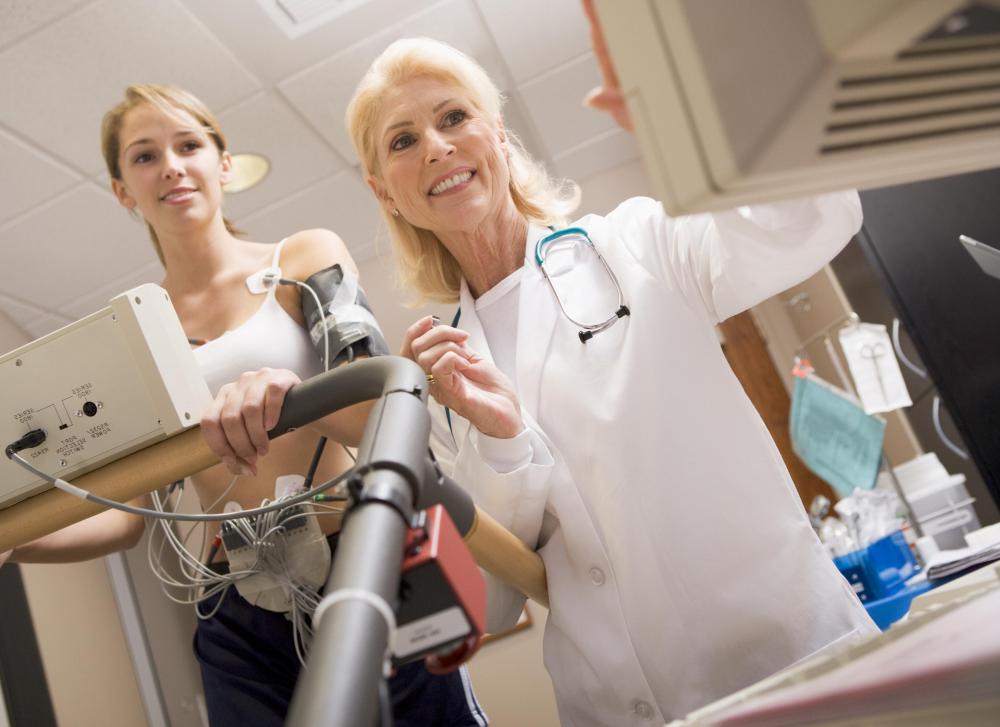At TheHealthBoard, we're committed to delivering accurate, trustworthy information. Our expert-authored content is rigorously fact-checked and sourced from credible authorities. Discover how we uphold the highest standards in providing you with reliable knowledge.
What is Aerobic Capacity?
Aerobic capacity is the maximum amount of oxygen that the body can utilize during an exercise session, usually measured during a brief period of high-intensity exercise. It is possible for a person to improve his or her aerobic capacity over time. A person might also experience a decline in this measurement as a result of a variety of factors, including aging, illness and a decline in physical activity. For elite athletes, their aerobic capacity — also known as VO2 max, short for volume of oxygen maximum — is an important aspect of their physical fitness. Aerobic capacity is not the same as lung capacity, which is simply the volume of air that a person's lungs can hold.
Oxygen Used During Exercise

When people exercise, the body needs to be able to utilize oxygen, which cells need in order to function. The lungs and cardiovascular system work in tandem to deliver oxygen to the body. The more people exercise, the more efficient the process becomes, and the more oxygen the body can utilize within a given period of time. As people are able to use more oxygen, they can work at a higher level of intensity, and their endurance also tends to be extended because they can work harder for longer.
Testing

Athletes and other people who are interested can undergo testing that will assess the function of their cardiorespiratory system. During this test, the person engages in aerobic exercise while the air that he or she inhales and exhales is monitored and the levels of oxygen and carbon dioxide in the air are measured. When the exhaled gases reach a steady state that does not change, the athlete has reached his or her aerobic capacity: no more oxygen can be used by the body, no matter how much harder the athlete works.
Causes of Decreased Aerobic Fitness

Many things can affect a person's aerobic capacity. Aging is a major factor, with people older than 40 usually experiencing a decline, even if they keep fit. Chronic illness and disease also can cause declines, which might be permanent or temporary, depending on the nature of the illness. Failure to keep up with a physical fitness plan will also contribute to a reduction in a person's VO2 max, because the body needs to be worked regularly to retain a high efficiency level with respect to utilizing oxygen. Even small amounts of physical activity every day can help people get and stay fit.
Improving Aerobic Fitness

Cardiovascular exercise is used to improve aerobic capacity by strengthening the heart muscle and developing the rest of the cardiorespiratory system. Many people who have started exercise plans have noted that, at the start, they tire quickly and breathe hard because their bodies cannot get enough oxygen. As their fitness program continues, however, their aerobic capacity improves, allowing them to exercise more vigorously and for longer periods of time.
AS FEATURED ON:
AS FEATURED ON:















Discussion Comments
@Iluviaporos - Don't get too caught up in this kind of testing though. I think it's important to focus on how a person feels rather than make it all about the numbers. Yes, a lot of people respond well to competition, even if the competition is with themselves, but other people can get stressed when they feel like they aren't hitting targets.
Talking to a fitness instructor can really help and if you pick the right one they will test you as well. I think it's easier to think of the test as being an interesting measure of how far you've come, rather than a means of spurring yourself to do better.
@aaaCookie - You might also want to do some kind of general fitness test every now and then in order to make sure you are ticking all the boxes. Oxygen uptake and the ability to run fast is only one component of fitness. You also want to maintain balance and flexibility and strength and probably other things that I don't know that much about.
If you have a look online you can probably find some suitable fitness tests that can tell you roughly how you're doing at all of these things.
Comfyshoes - I agree. I always feel better after a good workout. It is really a mood enhancer because the body releases endorphins that help you feel relaxed.
I sometimes do interval training in which I run on a treadmill and then jump rope and go back to the treadmill.
I try to vary the intensity and speed so that I develop my aerobic fitness and try to increase my endurance so that I can run longer.
I also try to do other aerobic activities so that my body does not get used to the same exercise over and over. I like to take spinning classes and have tried yoga but I think that it is so hard.
It is definitely harder than it looks. I have trouble with my flexibility but I am getting better.
I just want to say that participating in aerobic forms of exercise really strengthen your heart and lungs. It also helps you shed fat and allows you to sleep better.
I know that when I run I always feel so good afterward. It really relaxes me and gives me even more energy. I also know that the fitter I get the lower my resting heart rate is because my heart become more efficient.
When I want to drop weight fast I always step up my intensity in my aerobic exercise and it always works. Exercise benefits really show up in a lot of ways.
Generally, it can be hard to assess aerobic capacity without the testing mentioned here. Because I constantly want to see if I am running better or faster, I try to time myself doing the same route at least twice a week. I do it at least twice because then I can determine if I was having a good or a bad day one of the times. I find timing myself only once a week leaves too much margin for error/laziness, and then I don't work hard enough to improve.
I run about 5-6 times a week, at least 2 miles each time. I'm training for a marathon eventually, and a half marathon in the next year, I just wish it was easier to gauge my personal aerobic fitness on my own. yes, I can tell I'm getting better, it's just hard to tell how much better.
Post your comments